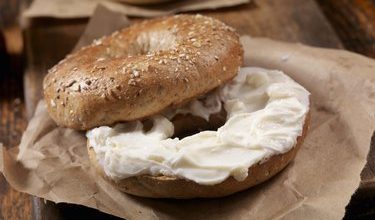Want to Lose 15 Pounds? Here’s Your Kickstart Plan

Drazen Zigic/iStock/GettyImages
Losing 15 pounds can be a realistic goal if have overweight, but doing it too quickly can backfire. Instead of trying to hit that number in, say, six weeks, health experts agree that a slow (but sure!) 1- or 2-pound weekly goal is your best bet. The reason: Slower, steady weight loss is easier to maintain — and who doesn’t want that?
“Most research has shown that when you lose weight at a slower pace, you are more likely to keep it off long term, and when you drop pounds too quickly, it can result in losing muscle rather than fat,” dietitian Nicole Hinckley, RD, tells LIVESTRONG.com.
Video of the Day
Video of the Day
And be wary of trendy or fad diets that promise quick weight loss, says the American Academy of Family Physicians. These too-good-to-be-true eating plans aren’t healthy and may actually be dangerous in certain cases.
Read on for more about the drawbacks of losing weight too quickly, along with an easy-to-follow plan full of great eating tips and exercise moves that’ll edge you toward fit and trim — and healthy.
Why Too-Fast Weight Loss Isn’t Smart
Creating a calorie deficit (aka burning more calories than you take in) is the first and most important step in losing 15 pounds, but cutting your calories too low isn’t the way to go about it. Fact: If you eat too little, you might not get the daily nutrition you need.
“This kind of crash dieting can affect your immunity, energy levels and even your hair — and those who restrict calories too much are more likely to overindulge later on,” Hinckley says. Too-fast weight loss could also mean you’ll lose water weight or lean muscle tissue rather than the fat you want to target, according to the Mayo Clinic.
“Rapid weight loss may also put you at a higher risk for other health complications like electrolyte imbalances, gallstones and dehydration,” adds dietitian Jonathan Valdez, RDN, owner of Genki Nutrition and a media spokesperson for the New York State Academy of Nutrition and Dietetics.
What’s worse, you could end up messing with your metabolism in a permanent way. “Studies have also shown that rapid weight loss may cause a long-term slowing of your metabolism, which will prompt weight to regain and could even result in a person having more overweight than they had before the diet,” Valdez says.
In other words, you could lose 15 pounds but then end up gaining back 20 or 25 before you know it.
Cut Calories the Right Way
Keeping track of the calories you eat is recommended when it comes to weight loss. To create the right calorie deficit to lose 15 pounds, you’ll first need to find out how many calories you need to maintain your current weight (sometimes called your “maintenance calories”), which is different for each person.
You can do this by keeping a food diary for a week or so, keeping track of both the total calories you eat and the calories you burn via exercise. You’ll also need to track your weight to determine if you gain, lose or stay the same.
Warning
Keep in mind that women shouldn’t fall below 1,200 calories a day and men shouldn’t take in fewer than 1,500 daily calories, according to Harvard Health Publishing. Dropping below these numbers could put you at risk for nutritional deficiencies.
Once you’ve established your baseline, the “magic” number of calories to cut each day is 500. Experts agree this is a safe amount that doesn’t put you at risk for deficiencies, but it’s enough to get the scale moving.
Because a pound equals about 3,500 calories, slashing 500 each day — through a combo of eating less and burning more through exercise — should help you lose about a pound each week, which means you can lose 15 pounds in less than four months.
Adjusting to a new diet may leave you feeling hungry, but you can make adjustments. “If you’re very hungry while on a diet, it’s possible to increase your calorie intake slightly, as long as you accompany this with an increase in exercise that results in a similar overall calorie deficit,” Valdez says.
For example, a person weighing 155 pounds who wants to add 300 calories a day due to hunger could counteract this by going for a 25-minute run each night or swimming for about 30 minutes, he says.
John D. Buffington/DigitalVision/GettyImages
Eat Well on Your Weight-Loss Plan
The key word here? Plan! “Make a meal plan for the week, which not only aids with grocery shopping but helps you avoid last-minute decisions when hungry, which is usually the biggest reason people turn to processed foods,” Valdez says.
By implementing a weekly eating plan, you’ll have carrot sticks and hummus or yogurt and nuts on hand when you’re feeling peckish and won’t be tempted to grab a bag of chips from the vending machine.
To stay fuller for longer while cutting back on calories, the Centers for Disease Control and Prevention recommends focusing on low-energy-dense (aka low-calorie) foods like fruits and vegetables, whole grains, beans and lean protein.
“These low-calorie foods are full of vitamins and minerals to help you meet your daily needs,” Valdez says.
Trimming a few extra calories here and there can be easy. For example, consider what you’re drinking each day. Sodas, high-calorie smoothies and alcohol can all add empty calories to your daily diet, per the U.S. National Library of Medicine. Swap these for low- or no-calorie drinks like water, black coffee or tea.
Ready to Lose Weight?
Here’s a seven-day, 1,500-calorie meal plan to get you started.
Combine Strength Training and Cardio
Regular exercise is an important part of any program to lose 15 pounds, but starting slowly is key if you haven’t been to the gym lately. The best exercise approach is one that combines a regimen you like to do and shows results.
“Easing into a workout routine will help you make fitness a part of your life without having it seem like an ‘all or nothing’ approach — and it may help you enjoy the process by not putting too much pressure on jumping into an intense program,” Hannah Davis, CSCS, a certified personal trainer and founder of Body by Hannah, tells LIVESTRONG.com.
According to the Physical Activity Guidelines for Americans, adults should get at least 150 minutes of moderate-intensity exercise (like walking or biking) or 75 minutes of vigorous-intensity exercise (like running) each week, and those who are trying to lose weight may want to aim for more.
Because muscle loss can occur on a reduced-calorie plan, include strength training as part of your workout regimen, too. The guidelines suggest training all your major muscle groups at least twice a week.
Davis recommends a focus on big movements that burn the most calories and build more muscle. “Start by adding a series of walking lunges (10 per leg), pushups (10), squats (10) and dumbbell rows (30) once a week for two weeks, increase it to twice a week for the next two weeks and then three times a week for the next three weeks — and even more if you can,” she says.
The American Council on Exercise also recommends these easy ways to add more fitness (and calorie burn) into your daily routine: parking your car farther from the stores you’re visiting, using the stairs instead of the elevator in your building or at work and taking breaks during the day to stand up and stretch.
Discover Your Ultimate Weight-Loss Workout Plan
Whether it’s pounding the pavement or hitting the gym, we’ve got your guide to working out for weight loss.




